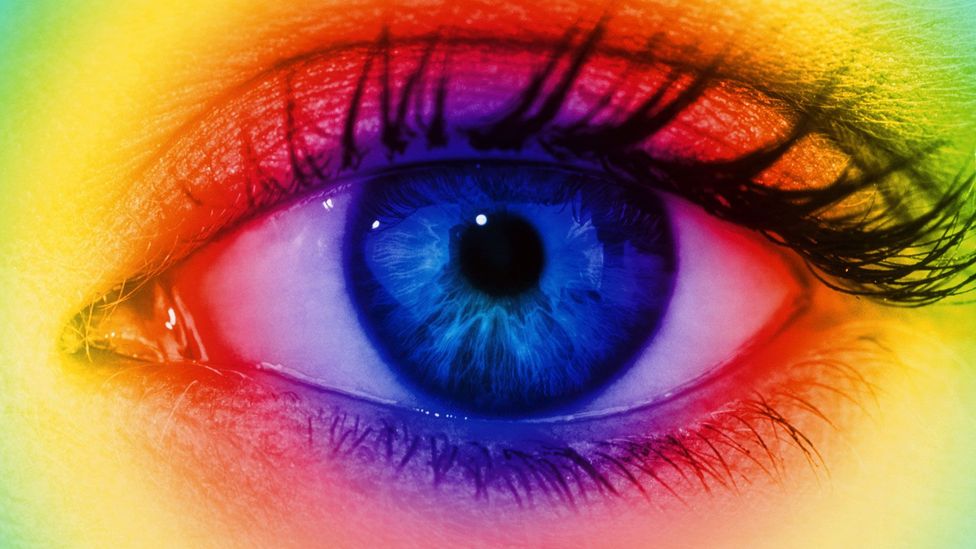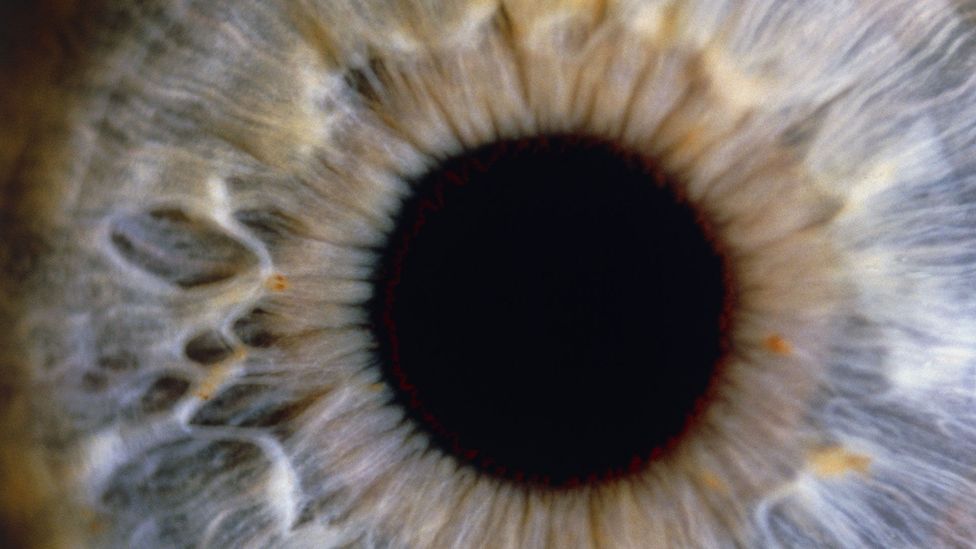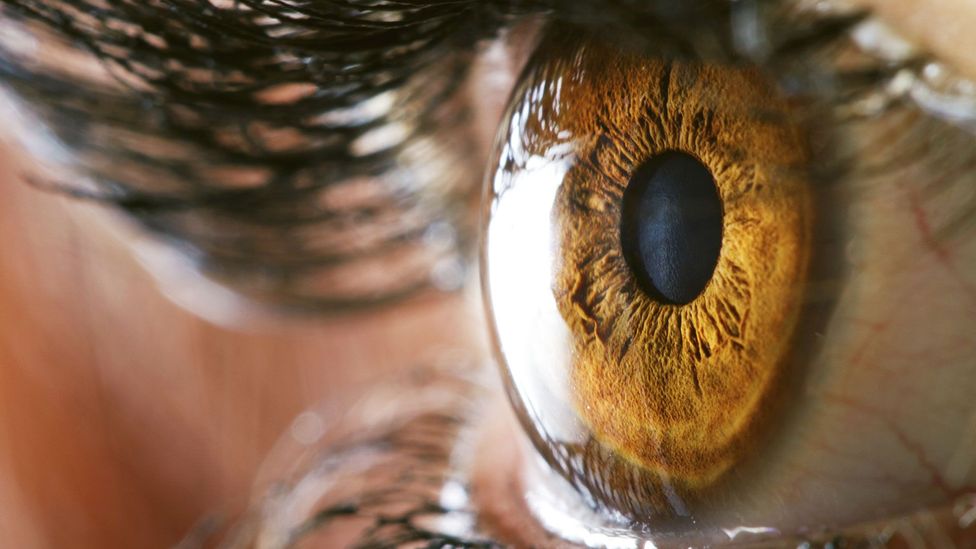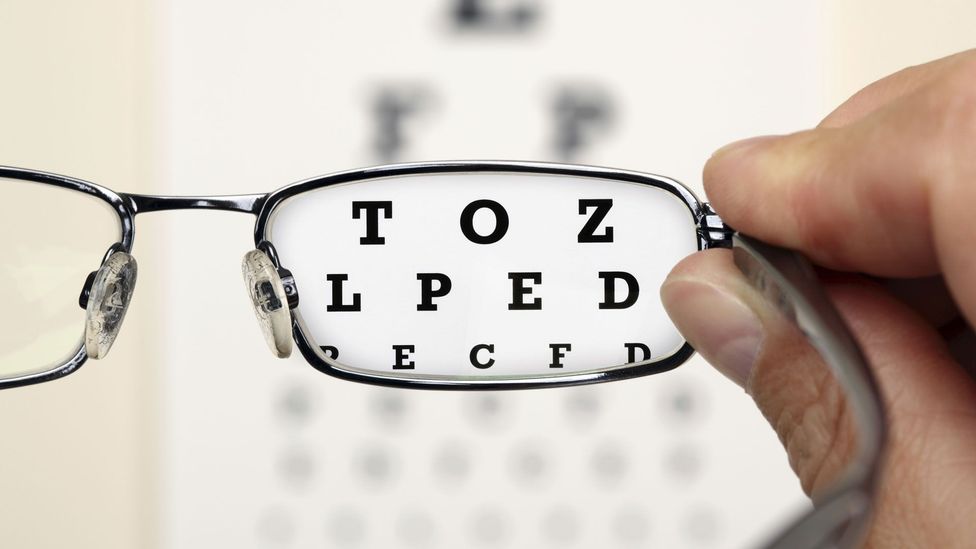How Many Frames Can a Human Eye See
What are the limits of human vision?

From spotting galaxies millions of calorie-free years away to perceiving invisible colours, Adam Hadhazy explains why your eyes can do incredible things.
T
Accept a look around the room – what do you see? All those colours, the walls, the windows – everything seems then self-evident, just so there. It's weird to retrieve that how we perceive this rich milieu boils down to light particles – called photons – bouncing off these objects and onto our eyeballs.
This photonic barrage gets soaked upwardly by approximately 126 million light-sensitive cells. The varying directions and energies of the photons are translated by our brain into dissimilar shapes, colours, brightness, all fashioning our technicolour world.
Wondrous as information technology is, our sense of vision is conspicuously not without certain limitations. We tin no more than see radio waves emanating from our electronic devices than we can spot the wee leaner correct under our noses. But with advances in physics and biology, we can examination the fundamental limits of natural vision. "Everything you can discern has a threshold, a lowest level above which you lot tin and below which y'all tin can't," says Michael Landy, professor of psychology and neural scientific discipline at New York Academy.

Cone cells deal in color, while rod cells let us to come across in grayscale in low-lite conditions (Credit: SPL)
We'll explain these visual thresholds initially through the lens – pun intended – of what many of the states first call up of when we consider vision: colour.
Why we perceive violet versus vermillion depends on the energy, or wavelengths, of the photons impinging on our retinas, located at the back of our eyeballs. There, nosotros have 2 types of photoreceptor cells, known as rods and cones. Cone cells deal in color, while rod cells allow us to run into in grayscale in low-light conditions, for instance at night.
Opsins, or paint molecules, in retinal cells absorb the electromagnetic energy from impacting photons, generating an electric impulse. That signal travels via the optic nerve to the encephalon, where the conscious perception of colour and imagery is created.
We accept three types of cone cells and corresponding opsins, and each peaks in sensitivity to photons of particular wavelengths. These cone cells are dubbed S, M, and 50, for short, medium and long wavelengths. Shorter wavelengths we perceive every bit bluer, while longer wavelengths are redder. All wavelengths in betwixt (and combinations of them) serve upward the full kaleidoscopic rainbow. "All lights we see – except those made artificially with a prism or some fancy device similar a laser – are mixtures of multiple wavelengths," says Landy.
Of all the possible photon wavelengths out there, our cone cells detect but a small sliver, typically in the range of most 380 to 720 nanometres – what we call the visible spectrum. Below our narrow perceptual ring is the infrared and radio spectrum, with the latter'due south longer, less energetic wavelengths ranging from a millimetre to kilometres in length.

Higher up our visible spectrum into higher energies and shorter wavelength nosotros find the ultraviolet band, and then X-rays, topping off with the gamma ray spectrum, whose wavelengths are in the mere trillionths-of-a-metre range.
While nearly of us are limited to the visible spectrum, people with a condition called aphakia possess ultraviolet vision. Aphakia is the lack of a lens, due to surgical removal for cataracts or congenital defects. The lens normally blocks ultraviolet light, so without it, people are able to meet across the visible spectrum and perceive wavelengths up to near 300 nanometres equally having a bluish-white color.
A study in 2022 pointed out that, in a manner of speaking, we all can run across infrared photons, too. If 2 infrared photons smack into a retinal cell nearly simultaneously, their energy can combine, converting them from an invisible wavelength of, say, yard nanometres to a visible 500 nanometres (a cool light-green to virtually eyes).
How many colours tin we see?
A salubrious homo eye has three types of cone cells, each of which can register about 100 dissimilar colour shades, therefore most researchers ballpark the number of colours nosotros tin can distinguish at around a 1000000. Nonetheless, perception of colour is a highly subjective ability that varies from person to person, thus making any hard-and-fast figure difficult to pinpoint.
"You lot'd exist hard-pressed to put a number on it," says Kimberly Jameson, an acquaintance project scientist at the Academy of California, Irvine. "What might exist possible with one person is only a fraction of the colours that some other person sees."

Some people can see in ultraviolet, but only after eye surgery (Credit: SPL)
Jameson knows what she'south talking nearly, given her work with "tetrachromats", people who possess apparent superhuman vision. These rare individuals, by and large women, have a genetic mutation granting them an actress, fourth cone jail cell. Equally a rough approximation based on the number of these extra cones, tetrachromats might meet 100 million colours. (People who are colour-blind, or dichromats, take only ii cones and encounter maybe x,000 colours.)
What's the smallest number of photons we need to see?
To yield colour vision, cone cells typically need a lot more lite to work with than their cousins, the rods. That's why in depression-calorie-free situations, color diminishes as the monochromatic rods take over visual duties.
In ideal lab atmospheric condition and in places on the retina where rod cells are largely absent-minded, cone cells can exist activated when struck by but a handful of photons. Rod cells, though, practice even better at picking up whatever ambience light is bachelor. As experiments first conducted in the 1940s bear witness, just one quanta of light can exist enough to trigger our awareness. "People can reply to a single photon," says Brian Wandell, professor of psychology and electrical applied science at Stanford. "In that location is no point in beingness any more sensitive."

What are the limits of your vision? (Credit: Thinkstock)
In 1941, Columbia Academy researchers led subjects into a darkened room and gave their optics some time to adjust. Rod cells take several minutes to achieve full sensitivity – which is why nosotros have problem seeing when the lights first go out.
The researchers and so flashed a blue-green light in front of the subjects' face up. At a rate meliorate than adventure, participants could detect the wink when as few equally 54 photons reached their optics.
After compensating for the loss of photons through absorption by other components in the eye, researchers found that equally few every bit five photons activating five separate rods triggered an awareness of light by the participants.
What is the smallest and farthest we can run into?
At present hither's a fact that may surprise yous: There is no intrinsic limit to the smallest or uttermost thing we can see. And so long as an object of whatever size, distance or brevity transfers a photon to a retinal prison cell, we can spy it.

Visual acuity drops off over greater distances (Credit: Thinkstock)
"All the eye cares about for vision is the amount of light that lands on the center," says Landy. "It'due south simply the total number of photons. So yous can make [a light source] ridiculously tiny and ridiculously cursory, simply if information technology'due south really potent in photons, y'all can nevertheless encounter it."
Psychology textbooks, for instance, routinely state that on a clear, nighttime night, a candle flame can be spotted from as far away equally 48 kilometres. In practice, of form, our eyes are routinely inundated by photons, and so devious quanta of light from keen distances get lost in the wash. "When you increase the groundwork intensity, the amount of actress light you need to come across something increases," says Landy.
The night heaven, with its dark background pricked past stars, offers some startling examples of long-distance vision. Stars are huge; many we see in the night sky are millions of kilometres in bore. Even the nearest stars, withal, are more than 24 trillion miles away, and are therefore then diminished in size our eye cannot resolve them. Lo and behold, nosotros tin can yet see stars equally intense, gleaming "point sources" of light because their photons cross the cosmic expanse and hit our retinas.

As long equally something is bright enough, you can encounter it from calorie-free years away (Credit: SPL)
All the individual stars we see in the night sky are in our galaxy – the Milky Way. The absolute farthest object we can run into with our naked eye is outside of our galaxy: the Andromeda Galaxy, located 2.5 million low-cal years from u.s.a., or a cool 23 quintillion miles. (Well, controversially, some bang-up-sighted folks take claimed to have glimpsed the Triangulum Milky way in extraordinarily dark night sky conditions, which is near 3 million low-cal-years distant, just we'll take to take their discussion for it.)
The trillion stars in the Andromeda Galaxy, on account of their extreme distance, add upward to just a fuzzily luminous patch in the sky. That said, the Andromeda Galaxy is colossal. In terms of its apparent size, even quintillions of miles away, the milky way is half dozen times the width of the total Moon. Just so few of its photons reach our eyes that this angelic behemoth is rendered faint.
How clearly can we see?
Notwithstanding, why is information technology that we tin't pick out individual stars in the Andromeda Milky way? The limits of our visual resolution, or acuity, come into play here. Visual acuity is the power to discern a detail such as a point or line as separate from another without them blurring together.
You might therefore call up of acuity'south limits every bit the number of "pixels" nosotros can discern.
Several factors set the boundaries for visual vigil, such as the spacing betwixt the cones and rods packed onto the retina. The optics of the eyeball itself, which as we mentioned before forbid every bachelor photon from alighting upon a photoreceptor cell, are important likewise.

Eye charts exam our ability to meet the black and white differences that form a letter (Credit: Thinkstock)
Theoretically, studies accept shown, the best we can do is nearly 120 pixels per degree of arc, a unit of angular measurement. That works out to most a fingernail held at arm's length with 60 horizontal and sixty vertical lines on it, alternating in black and white, creating a checkerboard pattern. "That's near the finest pattern you could ever see," says Landy.
Vision tests, like the popular Snellen heart chart at your optician's with the progressively smaller letters on it, operate on the aforementioned principle. The chart gauges at what signal someone can no longer separate out a white gap in a black letter, distinguishing a capital F from a capital P, for instance. These acuity limits help explicate why nosotros cannot discern and focus on a single, dim, biological cell that's mere micrometres across.
Only allow's non sell ourselves brusque. A meg colours; single photons; galactic realms quintillions of miles distant – not bad for the blobs of jelly in our eye sockets, wired to a 1.4 kilogram sponge in our skulls.
Follow uson Facebook , Twitter , Google+ and LinkedIn
Source: https://www.bbc.com/future/article/20150727-what-are-the-limits-of-human-vision
0 Response to "How Many Frames Can a Human Eye See"
Post a Comment